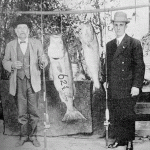Can the decline of an “invasive” species be taken as a sign of an ecosystem’s declining health?
That’s the question raised by an interesting Alastair Bland article in the East Bay Express on the latest numbers for striped bass in the Sacramento-San Joaquin-San Francisco Bay Delta system:
Scientists say the existing population may be as small as 5 percent of historic highs, and even diehard fishermen have given up trying to catch striped bass — once one of the most popular game fish on the West Coast.
Stripers aren’t native. As Bland notes, they were introduced via a small population in the 19th century. By the 1930s, according to Bland, their abundance supported a thriving commercial fishery, and they’ve long been a popular target of sport fishing. But there’s also been pressure to reduce their numbers because of the belief that they prey on endangered and threatened native fish like the delta smelt.
Given the smelt and their colleagues are the Endangered Species Act drivers now pushing delta habitat recovery and restoration efforts, what should we make of the decline of the striper? If what we’re trying to do is reduce jeopardy to specific listed species, shouldn’t we celebrate the decline of the striped bass? Or are we now dealing with such a fundamentally human-altered environment that the striped bass is an intrinsic part of the “social-ecological system” of the Bay-Delta of the 21st century?
Questions of science, questions of values, inextricably entangled at this point such that it’s hard to see where one stops and the other begins.


Pingback: Blog round-up: Stripers and nature, State Water Board’s water quality standards, BDCP, San Joaquin River restoration and more » MAVEN'S NOTEBOOK | MAVEN'S NOTEBOOK
Thought-provoking. But always so many questions and so few answers from you! 🙂
Pingback: Blog round-up: Stripers and nature in the Delta, State Water Board playing favorites, BDCP slieght of hand, irrigated ag in the Colorado River Basin and more